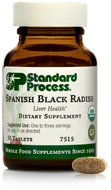Standard Process
Spanish Black Radish (30)
Spanish Black Radish (30)
Couldn't load pickup availability
Introduced in 1981
Spanish Black Radish is an organic supplement designed to support liver health with daily use, and support toxin elimination with acute use.*
- Our research shows that Spanish black radish induces the body's detoxification enzymes in cell and animal models*
- Supports healthy liver and gallbladder function*
- Encourages healthy digestion*
- 3 tablets per day supports the body's normal toxin-elimination function*
- Contains organically grown Spanish black radish from the Standard Process certified organic farm^
- Provides support for the body's organs*
Study Results: Liver Detoxification
Standard Process conducted an open-label pilot study to evaluate the efficacy of Spanish black radishes in inducing Phase I and II enzymes in healthy male subjects (n=20). Acetaminophen is metabolized in the liver through pathways that involve Phase II enzymes, including conjugation, sulfation, and glucuronidation, that produce measurable metabolites in blood and urine. Consumption of Spanish black radishes increased liver detoxification capacity and positively altered the metabolism of acetaminophen via increased urinary excretion.4
Benefits of Glucosinolates: How Spanish Black Radish Works
Spanish black radishes (Raphanus sativus l. var. niger) are particularly rich in a class of phytonutrients called glucosinolates, which have been associated with several beneficial health outcomes attributed to consumption of cruciferous vegetables.1, 2 The main mechanism of action through which metabolites of glucosinolates mediate their beneficial effects may be via the induction of metabolic detoxification Phase I and II enzymes, as well as induction of antioxidant enzymes.1-5 The glucosinolates in Spanish black radishes are unique in both content and concentration in comparison to other cruciferous vegetables.2 For example, the glucosinolates in Spanish black radishes make up over 4% in sprout of their total dry weight; glucosinolates in more common crucifers, such as broccoli, only constitute 1% of the broccoli sprout.2-4 In contrast to more common crucifers, >65% of the glucosinolates present in Spanish black radishes is glucoraphasatin.2 The metabolite of glucoraphasatin, 4-methylthio-3-butenyl isothiocyanate (raphasatin), carries similar potency as sulforaphane (the metabolite of glucoraphanin that is particularly abundant in broccoli) on Phase II gene expression.2,4
Metabolism of Toxins
Phase I and phase II detoxification enzymes work together to help the body break down and manage compounds that need to be removed. Mice fed a diet containing 20% Spanish black radishes for two weeks showed significant enhancement of the metabolism of toxins as demonstrated by significantly increased expression of Phase I and II detoxification enzymes.5Frequently Asked Questions
Radishes (Raphanus sativus L.) are a member of the cruciferous vegetable family that contains broccoli, cauliflower, cabbage, and kale. Radishes are available in varieties that differ in terms of size, shape, and color. Spanish Black Radishes (SBR) (Raphanus sativus l. var. niger) are a variety that is particularly rich in a class of phytonutrients called glucosinolates.
Synergistic Product Support
- Livaplex
- Garlic
- Cruciferous Complete
Complementary Educational Tools
- Spanish Black Radish Fact Sheet
- Research Report: Human Clinical Trial on the Detoxification Action of Spanish Black Radish in Men
- Research Report: Spanish Black Radish (Raphanus sativus I. var. niger) and Detoxification in Mice
- Detoxification Patient Brochure
- Red Our blog: What is Detoxing?
Suggested Use:
One to three servings per day, or as directed.
Acute Use: Three tablets per day to support toxin elimination*
Long-Term Use: one tablet per day to support liver health*

Share

